Bees seem like they’re always so busy. Most of the time, you see them hopping from flower to flower with seemingly no time for rest.
Bees primarily eat nectar and pollen. Bees derive their energy from nectar, while pollen is their source of nutrients and protein. But aside from these, bees are also attracted to sweet fruits such as pears, peaches, and grapes. They also drink water when they’re thirsty.
There’s so much more to learn about what bees eat. Are they herbivores? Do they eat meat? Is it a myth that bees eat dirt and wood? Read on to know the answers to these questions.
Table of Contents
How Often Do Bees Eat?
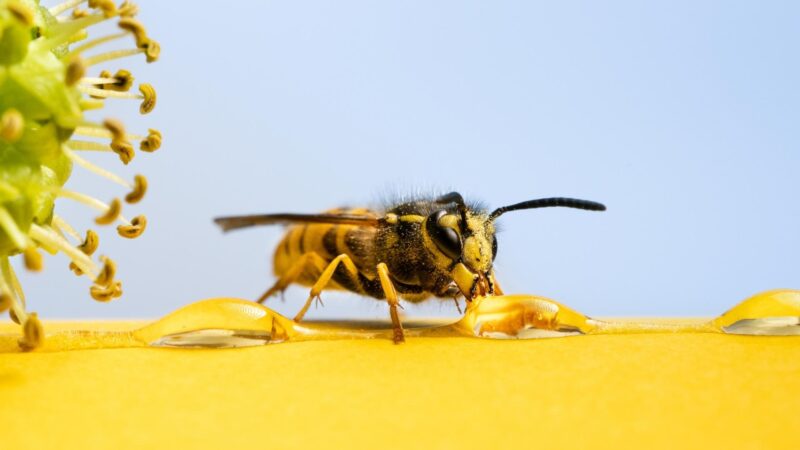
There is no definite period as to how often bees eat. However, studies show that a single bee needs around 0.37 ounces of food in a day. With that said, a colony of bees will require around 700 pounds of food in a year. If you’re responsible for feeding bees, then it’s necessary to make sure they have access to enough food to avoid starvation.
Additionally, it has been observed that a bee on a full stomach can fly for around an hour or less. Thus, forager bees need to eat often to make sure they have the strength to fly back to the hive after collecting nectar and pollen.
But aside from nectar and pollen, bees also need water to prevent them from becoming thirsty. They also collect water to dilute stored honey that has become too thick for their consumption.
Do Bees Eat Honey?
Bees do eat honey. Honey is derived from the nectar collected by bees and stored in the honeycomb. Because of the honeycomb’s shape accompanied by the fanning of bees’ wings, the nectar is broken down into simple sugars. The resulting liquid becomes honey.
The honey stored by bees then becomes their source of food through the winter season. However, it must be emphasized that bees should only eat honey from their hives. Raw honey from other sources may have been contaminated in the extraction process, and that may be dangerous for bees to consume.
Do Bees Eat Pollen?
Bees eat pollen. Pollen is a great source of protein, amino acids, and other nutrients, and that’s why it’s a staple in a bee’s diet.
Do Bees Eat Meat?
Generally, bees do not eat meat. By nature, bees are herbivores and therefore, only consume plant-based food. However, a bee subspecies called vulture bees have been observed to feed on rotting meat as their main source of protein.
Do Bees Eat Wood?
Bees do not eat wood. It has been observed that carpenter bees tend to carve or drill holes in wood. The purpose of this is to create a tunnel or gallery where they can lay eggs. However, they do not eat the wood parts that they carve out.
Do Bees Eat Other Insects?
Bees do not eat other insects. As previously discussed, bees are generally herbivores by nature. As such, they do not feed on other insects.
Do Bees Eat Leaves?
Bees do not eat leaves. While bees are known herbivores, they do not eat leaves.
While it has been observed that some bees cut out pieces of leaves – such as the Leafcutting Bee – they do not feed on leaves. Instead, they use them to make a nest for their larva.
Do Bees Eat Fruit?
Bees eat fruits. Bees are naturally attracted to sweet food, such as peaches, pears, apples, plums, and grapes.
Do Bees Eat Bread?
Bees do not eat bread. However, this should not be confused with bee bread, which is a mixture made of pollen, honey, and bee enzymes. Bee bread is the food source of larvae, nursing bees, and worker bees.
Do Bees Eat Dirt?
Bees do not eat dirt. While mason bees have been observed to collect mud, they do not do so to feed on them. Instead, these bee subspecies use dirt or mud to make their nest.
What Do Queen Bees Eat?
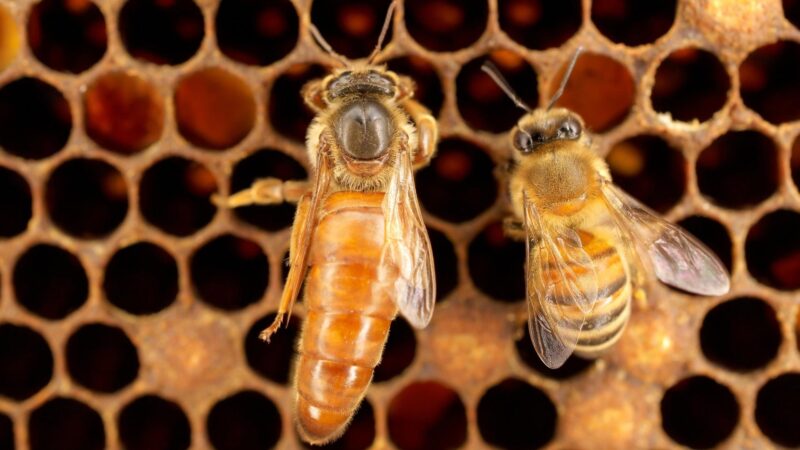
Queen bees eat royal jelly. Royal jelly is a bee secretion produced by a worker bee’s hypopharyngeal gland after consuming nectar and pollen. The resulting jelly-like substance is considered a potent source of nutrients, which is why it is fed to the queen bee to support its healthy egg-laying.
Studies reveal that royal jelly contains water, proteins, carbohydrates, vitamins, and a variety of bioactive compounds. Aside from providing the queen with a balanced meal, it also has immunomodulatory properties to strengthen its immunity.
Because of all these health benefits, royal jelly is also fed to larvae during its first three days. Additionally, once the workers have chosen which larvae will become the next queen, the chosen larvae will then be bathed and fed continuously with royal jelly.
What Eats Bees?
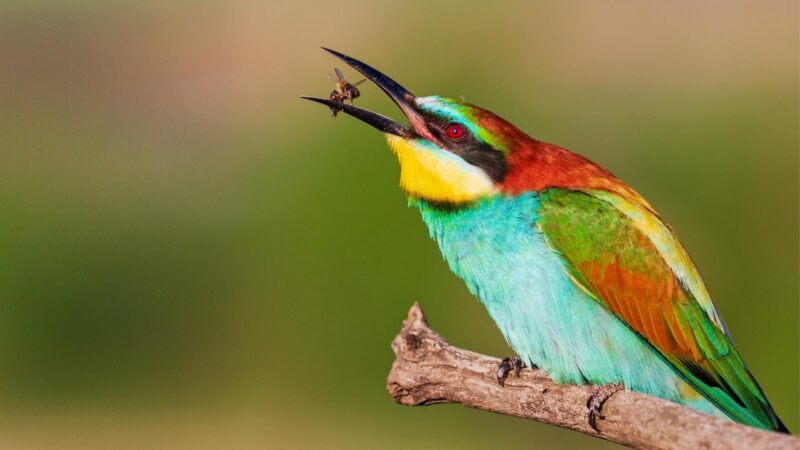
While bees are known for their painful stings, they are still considered prey rather than predators. But because of the venom sac in their bodies, most of their predators are merely opportunistic. This means that they only eat bees when the opportunity arises.
Some popular bee predators include frogs, lizards, birds, dragonflies, and spiders, to name a few.
Do Birds Eat Bees?
Birds are known predators of bees. Specifically, birds like woodpeckers, swifts, kingbirds, and mockingbirds feed on bees, including bee larvae. However, it must be noted that birds are usually opportunistic bee-eaters. That means they only feed on bees when the opportunity presents itself.
Do Bats Eat Bees?
Bats do not eat bees. While bats are known to prey on insects, it must be noted that bats are nocturnal while bees are diurnal. Because one is more active during the night while the other is active during the day, bats and bees rarely come across each other.
Do Dragonflies Eat Bees?
Dragonflies eat bees. Dragonflies are classified as carnivores, and they often prey on insects like bees and mosquitos.
Do Frogs Eat Bees?
Frogs eat bees. Frogs are amphibians known to feast on insects for survival – and bees are among these insects.
Do Spiders Eat Bees?
Spiders eat bees. Spiders feed on insects, and that includes bees. They often do so by quickly wrapping the bee and paralyzing it to prevent its escape.
Do Wasps Eat Bees?
Surprisingly, wasps do eat bees. Wasps and bees belong to the Hymenoptera insect family, which means that they are closely related. However, wasps are classified as omnivores, while bees are herbivores.
As omnivores, wasps are known to consume smaller insects. Being larger and longer than most bee species, wasps also prey on bees when the opportunity presents itself.
Do Chickens Eat Bees?
Chickens eat bees. Chickens are omnivorous foragers and will consume whatever’s in their path, whether weeds, seeds, and small insects. With that said, chickens also consume dead bees if there are some in their foraging path.
Do Lizards Eat Bees?
Lizards eat bees. Like most reptiles, lizards also eat insects, including bees. Since bees are known to fight back, a lizard does so by trapping an unsuspecting bee with its long and sticky tongue before eating it.
What Do Bees Eat in Winter?
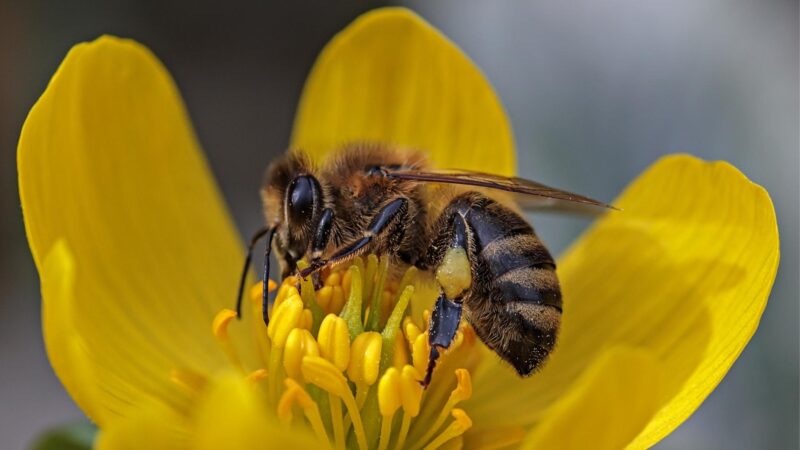
During the winter, bees eat honey. Honey results from a chemical supersaturation of nectar after it has been regurgitated by bees. Part of the process of producing honey involves water evaporation, which results from fanning it with bees’ wings. The resulting liquid is high in carbohydrates, sugar, water, and other vitamins and minerals.
With that said, honey is not made overnight. A hive’s honey storage is usually the result of months of collecting nectar from plants over the spring and fall seasons. This is to make sure that they have enough to eat during the cold winter.
It must be noted that bees are not usually meant for cold weather, which is why they only spend the winter months inside the hive. Bees often stay huddled together to stay warm and feed on honey until the temperatures rise again. Without their honey storage, bees can easily die from starvation and freezing.
What Do Baby Bees Eat?
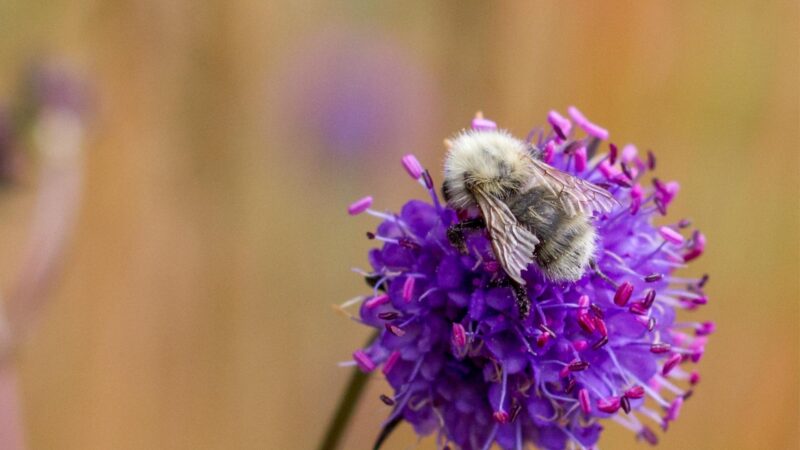
Baby bees, otherwise known as bee larvae, are fed royal jelly and bee bread. As earlier discussed, larvae are fed royal jelly during their first days of life. After that, only the larvae chosen to be a queen will receive royal jelly.
As for the rest of the larvae, they will be fed bee bread. Bee bread is made from a mixture of pollen, honey or nectar, and salivary enzymes, which then go through a lactic acid fermentation process. It is high in fatty acids, water, and protein, making it a healthy source of sustenance for growing bees.
In conclusion, a bee’s diet mainly consists of nectar, pollen, and water. During the winter months when there’s no flower to forage, bees resort to eating their stored honey to survive. But for the queen bee, the royal jelly is its primary source of nutrition. Nevertheless, these food choices reflect how bees are smart enough to know which food will give them energy and nutrition.
List of Sources
Huang, Z. (2018). Feeding Honey Bees. Michigan Pollinator Initiative.
Anton, K., Grozinger, C. (2020). An Introduction to Queen Honey Bee Development. PennState Extension.
Garvey, K. K. (2014). Honey Bees Need Water, Too! Agriculture and Natural Resources, University of California
Kaplan, M., et al. (2016). Fatty Acid and Proximate Composition of Bee Bread. Food Technology and Biotechnology.
What Bees Eat. University of Arizona.
